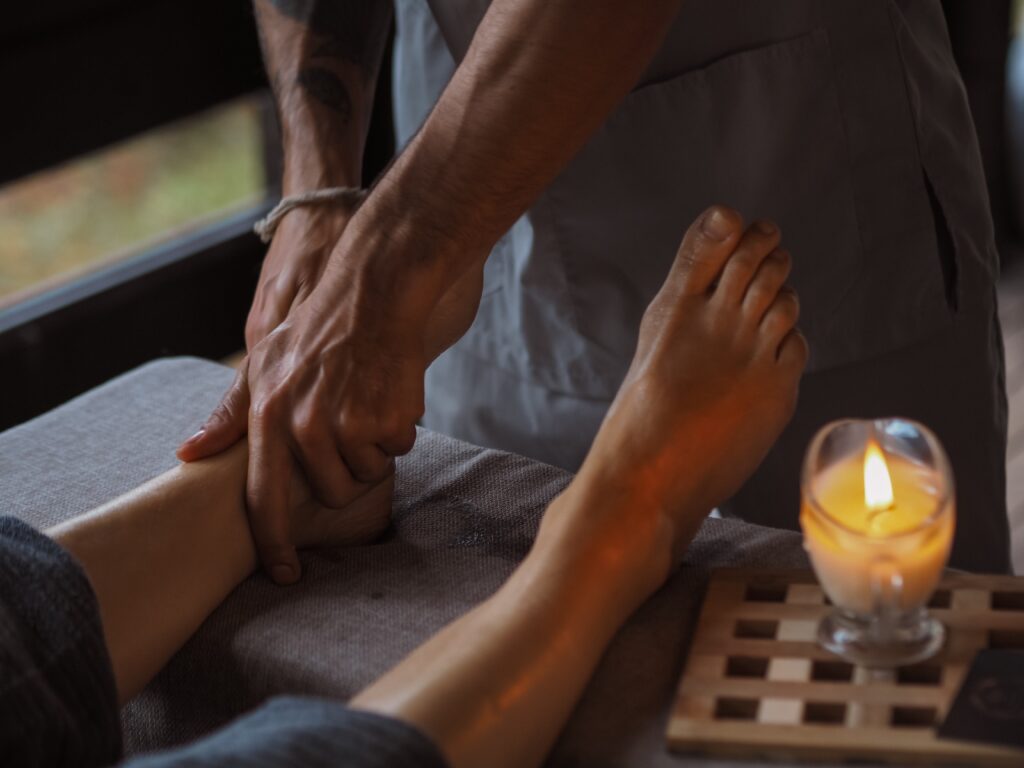According to the Pharmaceutical Journal, thermotherapy is defined as the application of any substance to the body that increases tissue temperature. Heat therapy, or thermotherapy, can refer to any method of applying warmth to the body, either in one particular area or over the entire body. Most commonly, thermotherapy is used in case of injuries or for pain relief, though it could also have other uses or medical benefits as heat widens blood vessels, and increases blood flow to the skin.

Highlights
- Thermotherapy has improved blood flow, tissue metabolism and connective tissue extensibility,
- Increased blood flow also facilitates tissue healing by supplying protein, nutrients and oxygen at the site of an injury,
- Consequently, it relaxes muscles it comes into contact with, decreases muscle spasms and reduces the stiffness of joints.
Types of thermotherapy
Regular exposure to heat therapy in the form of saunas and compresses has been used for medicinal purposes since ancient times. Both types of heat therapy warm up the body gradually. Moreover, in some situations, thermotherapy should be avoided or applied with caution. For instance, when an area has an open wound, swelling or inflammation, heat therapy should not be used at all.
There are two different kinds of heat therapy:
1. Dry heat therapy: Dry heat therapy includes the use of heating pads, heated gel packs, heat wraps, heat lamps and so on. These methods are easier when you are trying to treat an isolated muscle, organ or body part. For example, if someone is suffering from a sore hamstring or experiencing menstrual cramps, applying a heating pad can effectively relieve pain because the heat is concentrated in that particular area.
2. Moist heat therapy: Moist heat therapy, on the other hand, comprises warm baths, saunas, hot tubs, warm damp towels and even paraffin wax treatment. Moist heat methods are often considered easier for whole-body treatments. For example, a warm bath or hot sauna will warm up the entire body much more effectively. These can be used for muscle soreness and different kinds of recovery.
There are also other professional heat therapy treatments, such as heat from an ultrasound, infrared heat therapy and others, that are used for particular conditions or in professional environments. The choice of thermotherapy usually depends on the conditions that lead to any kind of discomfort and your personal preferences. Similarly, individuals with neuropathy (damage or impairment of nerve endings or the nervous system) or any kind of decreased nerve sensations should be careful with thermotherapy, as they may not be able to tell when the temperature increases too much; in extreme cases, this could lead to inadvertent burns. That said, when used correctly, thermotherapy has been reported to deliver some great results.

Benefits of thermotherapy
Thermotherapy is used primarily for muscle injuries, pain relief and overall fitness. However, it also has a variety of other benefits and potential applications that are explored below.
1. Pain relief: Studies have found that thermotherapy could relieve acute back pain, as well as stiffness and soreness. Reviews have also shown the effectiveness of thermotherapy in the rehabilitation of skeletal muscle injuries and in the management of conditions associated with chronic pain. Blood flow to a particular muscle increases when its temperature increases. This can soothe discomfort and has other benefits.
For instance, after a vigorous bout of exercise, also known as anaerobic exercise – an activity that converts glucose into energy without the use of oxygen, like strength training, where your body requires more energy than produced through aerobic respiration, leading to a build-up of lactic acid in the overworked muscles. When heat is applied to an area that has a build-up of lactic acid, the blood vessels expand slightly and blood flow increases, which helps with the transport of excess lactic acid and other toxins away from those muscles, bringing relief and accelerating cell metabolism. Heat also increases oxygen uptake and accelerates tissue healing.
2. Vasodilation: Due to the widening of the blood vessels near the surface of the skin, your metabolic rate also increases. In turn, this helps the healing process by increasing the catabolic and anabolic reactions that comprise metabolism, both of which are required to process and remove the metabolic by-products of tissue damage at a cellular level. This counteracts the activity of destructive enzymes, such as collagenase, and can also reduce oxidative stress. Oxidative stress is a disruption of the cellular equilibrium between free radicals and antioxidants, and is correlated to glucose variability, disrupted metabolic health and ageing or degenerative diseases.

3. Angiogenesis: The formation of new blood vessels in skeletal muscle, which increases blood flow and improves tissue extensibility, and the flexibility of connecting tissues. Thus muscles are also made more elastic by heat, improving flexibility, and nerve endings are stimulated to block pain signals. For this reason, pain from injuries, chronic pain, soreness and even arthritis can be relieved or reduced with heat therapy.
4. Longevity: Thermotherapy has been reported to display benefits in improving cellular health and thus enhancing longevity. Thermotherapy has a hormetic effect. In the fields of biology and medicine, hormesis is defined as an ‘adaptive response of cells and organisms to moderate (usually intermittent) stress’. Exercise, dietary energy restriction and exposures to low doses of certain phytochemicals are some instances of activities that have a hormetic effect.
In the presence of heat stress that occurs due to thermotherapy, heat shock proteins (HSPs) help protect the body by scavenging free radicals (unstable atoms that can damage cells) supporting cellular antioxidant capacity and thus reducing oxidative stress. HSPs also repair damaged proteins, allowing them to return to their proper structure and function. Structurally intact proteins are critical for maintaining the normal functioning of cellular mechanisms.
Research has indicated that exposure of cells to mild heat stress can protect them from damage by oxidative stress or toxins. Regular use of thermotherapy techniques such as a sauna or warm bath can have long-term health benefits. In fact, heat stress has also been shown to activate FOX03, a well-known longevity gene. However, more research is required to ascertain what forms of thermotherapy would be most effective for long-term health benefits.
5. Heart health: The metabolic effects of heat therapy have led to research into its benefits for cardiovascular health. In recent years, several studies have examined thermal therapy as one alternative to exercise for patients who are elderly, obese or otherwise unable to exercise regularly. A number of studies have examined whether heat therapy, primarily through methods such as saunas and bathing, can achieve benefits similar to those of exercise. They found that the efficacy of thermal therapy on cardiovascular health can be demonstrated and shows great promise. However, there needs to be more research to determine whether the benefits of thermotherapy shown in young, healthy subjects could be achieved in patients with significant risk factors for cardiovascular illness.

So far, thermotherapy has been studied as a preventative measure for cardiovascular disease. But evidence suggests that there can also be risks for some people, such as those prone to orthostatic hypotension (a condition in which you are prone to sudden blood pressure drops that can be dangerous). They should avoid heat therapy because of the significant decrease in blood pressure, which usually occurs immediately after heat therapy. Although heat therapy requires significantly more research before being commonly considered a treatment for patients with cardiovascular disease. But its effects on circulation, metabolism and blood pressure suggest it is a viable option for individuals who are not at risk.
6. Hormones: The practice of thermotherapy has been reported to have potential benefits for mental health as well because it releases ‘happy hormones’. Studies have shown that the use of infrared heat or saunas can have therapeutic benefits for people with depression because it activates the release or reuptake of serotonin in the brain. Moreover, these effects were observed even days after the heat therapy. Researchers at the University of Arizona (UA) are exploring how whole-body hyperthermia could improve depressive symptoms, reduce stress and improve sleep. One of the hypothesised causes of this is that serotonin, dopamine and norepinephrine all play a role in thermoregulation (maintaining the core body temperature).
Dr Charles Raison, a UA associate professor of psychiatry has spearheaded research that suggests inflammation can prompt the brain to get depressed. This led him to investigate other sensory pathways, like the one linking the skin and the brain. He discovered that the pathways implicated in thermoregulation are also the ones related to depression. His research indicates that norepinephrine, dopamine and serotonin, held as anti-depression chemicals, are thermoregulatory chemicals as well. However, more research is required to fully understand the link between these hormones, thermotherapy and overall health and mood.
7. Glucose tolerance: Thermotherapy is also tied to glucose tolerance, as it has been reported to affect cell metabolism. For instance, the heat from saunas or spas, or thermotherapy more broadly, can affect blood glucose in the following ways:
- It can lead to excessive sweating, which can result in dehydration, producing a decrease in blood volume and, consequently, higher blood glucose levels.
- It may increase the levels of certain hormones that oppose the action of insulin, such as growth hormone and glucagon, which raise the blood sugar and thus have a hyperglycemic effect.
- It has also been reported to dilate the blood vessels, which may increase the speed of insulin absorption and lead to unusual variations in blood glucose levels.
A recent study has also shown that heat therapy improves blood glucose levels and generally improves insulin signalling in fat cells. This suggests increased fat metabolism in these cells, which balances blood glucose levels. Other research has also shown that thermotherapy can improve glucose tolerance. In one study, 30 one-hour hot tub sessions (40.5°C for 60 minutes) over 8–10 weeks reduced fasting glucose and improved glucose and insulin sensitivity in women with polycystic ovary syndrome, a neuroendocrine disorder characterised by marked insulin resistance.
As a potential form of exercise replacement for people with type 2 diabetes, thermotherapy mimics the increase in body temperature that is caused by exercise. Heat stress treatments using either water or air have demonstrated positive effects such as the increased presence of heat shock proteins, reduction of oxidative stress and increased insulin sensitivity.
8. Fitness: Apart from benefits in terms of pain relief, cardiovascular health and glucose tolerance, thermotherapy is also considered to be useful in general fitness, for both warm-up and recovery. This is because heat therapy warms connective tissue (muscles, tendons, ligaments), which allows them to stretch and move more easily, and thus aids in injury prevention. Thus, it is often used by athletes as part of a warm-up routine. While heat therapy is unnecessary for most people before stretching or exercise, it may benefit individuals who have excess scar tissue or those who experience tightness in particular areas before a workout. The heat helps increase blood flow to the area and increase tissue elasticity so that the muscles are ready to work at a higher rate.

9. Muscle growth: For people recovering from injuries or in cases where muscles have atrophied, thermotherapy has been found to be very beneficial in improving recovery and promoting muscle growth. One study suggests that thermotherapy administered before exercise advances the effect of the exercise and enhances muscle growth in individuals with disuse muscle atrophy and elderly persons. Research also suggests that heat-based interventions may improve muscular health after injuries that lead to temporary immobilisation or reduced movement. Heat may reduce the loss of muscle mass and/or improve elements of muscular contraction in these situations, leading to faster recoveries and quicker growth of the muscles involved.
Side effects of thermotherapy
Although thermotherapy can be useful for a variety of reasons, as explained above, there are also potential side effects. The most common one is overheating or burns. When using heat therapy, it is important to be very careful about burns. Place insulation between the heat source and skin and ensure you monitor the time of use. Falling asleep with any heated therapy treatment in contact with skin can be dangerous. Similarly, if you have an infection, heat therapy must be avoided, as there is a chance that it could increase the risk of the infection spreading. It should also be used with caution for patients with burns, skin ulceration, wounds or inflamed skin.
When to avoid thermotherapy?
There are certain cases where heat therapy should not be used. In people with diabetes, peripheral vascular diseases, dermatitis, multiple sclerosis or rheumatoid arthritis, thermotherapy must be avoided, as it may increase disease progression. Similarly, people with hypertension or pregnant women should consult with a medical professional before using saunas, hot tubs or any other form of thermotherapy. In terms of injuries, it is important to know what kind of injuries require cold therapy rather than heat therapy, as cooling down an area reduces blood flow and inflammation. If the area in question is bruised, swollen, or both, it may be more appropriate to use cold therapy, while heat therapy is better for soreness, stiffness, pain, etc.
Conclusion
Thermotherapy has come a long way in recent years, and new applications of it continue to be discovered. Research suggests that the application of heat improves circulation, blood flow and metabolic rate, and can be very beneficial for pain relief, cardiovascular health, glucose metabolism and muscle recovery or overall fitness. Nonetheless, it is important to know when thermotherapy should and shouldn’t be done. Far more research is required to better understand all of its possible uses, particularly for people with certain medical conditions or some types of injuries.
Disclaimer: The contents of this article are for general information and educational purposes only. It neither provides any medical advice nor intends to substitute professional medical opinion on the treatment, diagnosis, prevention or alleviation of any disease, disorder or disability. Always consult with your doctor or qualified healthcare professional about your health condition and/or concerns before undertaking a new health care regimen including making any dietary or lifestyle changes.
References







